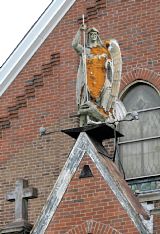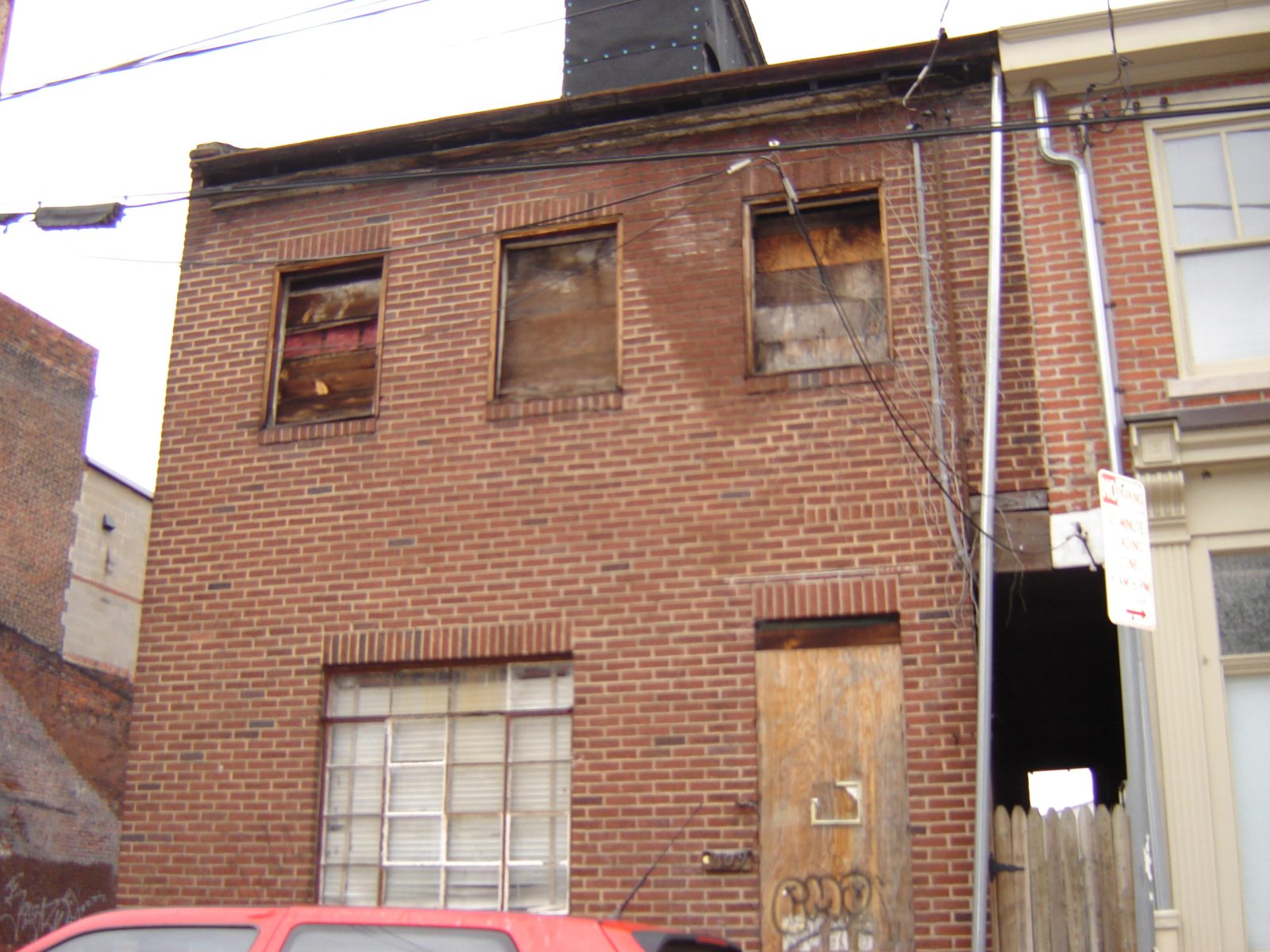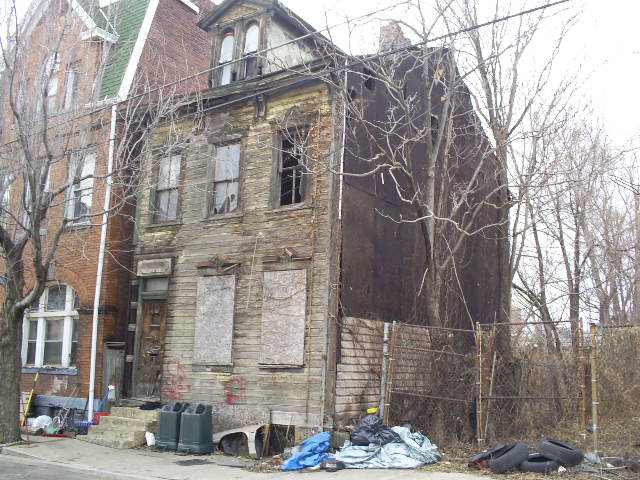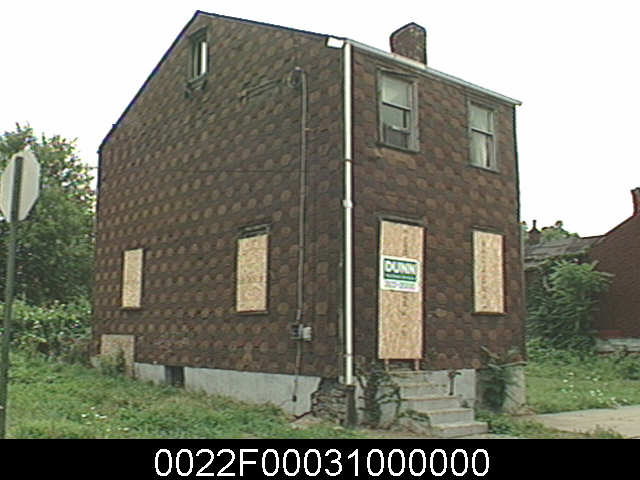
Category Archive: Preservation Alert
-
Pa. Historical Panel Raises Concerns About Mellon Arena
Thursday, June 17, 2010By Katie Falloon, Pittsburgh Post-GazetteThe Pennsylvania Historical and Museum Commission has expressed concerns about the speed of the planned demolition of the Mellon Arena, prompting a response today from the Sports & Exhibition Authority.
In the commission’s letter sent Wednesday, director Jean Cutler requested more information.
“We are sympathetic with the need to move quickly, however we also want to ensure that we have received all crucial information in a fashion that allows us to fully understand both the process and the project’s effects on historic resources,” Ms. Cutler said in the letter.
Following today’s SEA board meeting, Executive Director Mary Conturo said members think moving through the process quickly is best, Ms. Conturo said. Mellon Arena will be vacant come August, and the costs of maintaining the building will fall on SEA, she said.
Utilities and insurance for the arena will cost between $78,000 and $100,000 per month, depending on whether the intention is to keep the arena dark or there is an opportunity for reuse, said Christen Cieslak, principal at Chronicle Consulting.
“We think everything done to date is very thorough and very well done,” Ms. Conturo said.
-
SEA Consultants Advise Razing Mellon Arena
By Adam Brandolph
PITTSBURGH TRIBUNE-REVIEW
Thursday, June 10, 2010Consultants for the city-county Sports & Exhibition Authority recommended in a draft report sent to the state Bureau of Historic Preservation that Mellon Arena be demolished and the 28-acre Uptown site be developed, SEA officials confirmed Wednesday.
The report, according to Chris Cieslak, a consultant working with Oxford Development and the SEA, “evaluates several alternatives,” but concludes that the Penguins’ plan to demolish the arena and construct a mixed-use development on the site would have the greatest economic benefit to the region. A full copy of the report, which was sent to the preservation bureau last month, was not available.
Representatives from two groups seeking alternatives to demolition walked out of last night’s closed-door meeting with SEA officials and other interested parties because they said the historic preservation process is not being followed.
“Their process is designed to divide and conquer,” said architect Rob Pfaffman. “The democratic process is being badly managed and badly executed.”
The SEA has hosted six other closed-door meetings that included developers and preservationists. A public meeting was held in the lower Hill District last month.
The $321 million Consol Energy Center is set to open across the street from the 49-year-old arena this summer. The main tenant, the Penguins, own the rights to develop the property.
Pittsburgh Mayor Luke Ravenstahl, Allegheny County Executive Dan Onorato and other public officials have said Mellon Arena should be demolished to create room for retail and housing developments. The Sports & Exhibition Authority — whose members are appointed by the mayor and county executive — has the final say on what will happen but has not made public any decision.
The preservation bureau has 30 days to review the draft report, while a consulting firm hired by the two groups seeking alternatives to demolition completes its own study.
“Everybody’s trying to beat the clock now,” said Todd Poole, managing principal of 4Ward Planning, representing Preservation Pittsburgh and ReUse the Igloo. “Obviously, I think from the standpoint of my clients, they would prefer that the process not be rushed.”
Poole hopes to have a “fully fleshed-out analysis that covers all the bases that we’ve discussed to this point” by early July. Poole said the SEA consultant’s plan falls short of a full analysis of what could be done with the arena. He said adding more retail space to an area with vacancies is a poor idea.
Gary J. English, a Penn Hills resident who filed for the Igloo’s historic preservation and has attended the SEA’s closed-door meetings, wants Allegheny County voters to decide the fate of the arena with a ballot initiative.
“I think the whole process is a farce,” English said. “They had one public meeting in the Hill District, but (the arena’s) owned by the residents of the entire county.”
-
Historic Mann’s Hotel Demolished
PHLF News
October 12, 2009The historic Mann’s Hotel in McKees Rocks, Pennsylvania, located at 23 Singer Avenue was demolished in the early hours of October 10, 2009. The hotel was built in the early 1800s and functioned as a hostelry for many years.
The Mann family Ted and Karen Suslovic-Mann tried to continue the operation of the hotel, serving the traditional turtle soup to many loyal customers at lunch and dinner and wanted to develop it as a B & B, but the costs were too high. They tried valiantly for years and our president Arthur Ziegler met with them many times to see if a feasible plan could be developed. Catherine Baker Knoll, when she was Lieutenant Governor, also communicated with us a number times as she too struggled to save the hotel.
When its doom seemed to be sealed, Mike Shealey and others developed a plan to salvage what could be saved and to photo document the building as it was taken down, but surprisingly it vanished on October 10, 2009 demolished by the authorities in McKees Rocks in the early hours.
-
Landmarks supports the nomination of the Old Stone Tavern as a City-Designated Historic Structure.
PREPARED TESTIMONY OF
ANNE E. NELSON, ESQ.
GENERAL COUNSEL
PITTSBURGH HISTORY & LANDMARKS FOUNDATION
BEFORE HISTORIC REVIEW COMMISSION, CITY OF PITTSBURGH
PUBLIC HEARING ON THE OLD STONE TAVERN
CITY HISTORIC STRUCTURE NOMINATIONApril 1, 2009
Landmarks supports the nomination of the Old Stone Tavern to become a City-Designated Historic Structure.
The building was surveyed in both of Landmarks’ architectural surveys of Allegheny County and was chosen for inclusion in Landmark Architecture of Allegheny County Pennsylvania by James D. Van Trump and Arthur P. Ziegler, Jr., published in 1967, and Pittsburgh’s Landmark Architecture by Walter Kidney, published in 1997.
Walter Kidney dates the building c. 1800 since it is “a work in masonry not logs.” Van Trump and Ziegler describe the building as “[o]ne of the earliest surviving local taverns,” and state that “[t]his tavern must be preserved….”
Therefore, Landmarks supports the nomination of the Old Stone Tavern.
-
Landmarks Joins City of Chicago’s Appeal of Landmark Decision
by Anne E. Nelson, General Counsel
PHLF News
March 11, 2009On March 11, 2009, Landmarks joined the National Trust for Historic Preservation, Landmarks Illinois, New York Landmarks Conservancy, Cleveland Restoration Society, sixty-three Illinois municipalities and other organizations in filing an amicus curiae motion before the Supreme Court of Illinois in the case Hanna v. City of Chicago. In Hanna, two Chicago property owners challenged the constitutionality of the city’s landmark ordinance creating a historic district that included the property they owned. The property owners were successful at the appellate court level.
The brief urged the Supreme Court of Illinois to accept the City of Chicago’s Leave to Appeal and to reverse the appellate court’s decision that Chicago’s landmarks ordinance was “vague, ambiguous, and overly broad,” and that, as such, the ordinance amounted to an unconstitutional delegation of discretionary authority by the Chicago City Council to the Landmarks Commission.
The brief made the following four arguments:
- The appellate court’s opinion threatens the validity of similar laws and ordinances throughout Illinois;
- The United States District Court upheld the constitutionality of Chicago’s landmark ordinance against a vagueness challenge in 1977 and 1994;
- In other states, courts have overwhelmingly rejected vagueness challenges to criteria for designating landmarks and historic districts in local preservation ordinances; and
- Courts have upheld preservation ordinances in 24 states and the District of Columbia against vagueness and unlawful delegation claims.
On March 24, 2009, the Illinois Supreme Court denied the motion of the amici to file a state in support of the City of Chicago’s petition. While disappointing, the filing was still successful in calling the court’s attention to the many cities and organizations from around the nation that support the City of Chicago’s position.
-
Landmarks opposes the demolitions of 1403 and 1414 Nixon Street and 1109 Bingham Street
PREPARED TESTIMONY OF
ANNE E. NELSON, ESQ., GENERAL COUNSEL
PITTSBURGH HISTORY & LANDMARKS FOUNDATIONBEFORE HISTORIC REVIEW COMMISSION,
CITY OF PITTSBURGH PUBLIC HEARING ON CITY DEMOLITIONSJANUARY 7, 2008
Landmarks opposes the demolitions of 1403 and 1414 Nixon Street and 1109 Bingham Street because the City was instructed by the U.S. Department of Housing and Urban Development (HUD) to cease all demolition activities for any buildings located in National Register eligible or listed or local designated historic districts until the City complies with Section 106 of the National Historic Preservation Act and revises its procedures and relevant documentation.
HUD reiterated its instructions and concerns with the City’s Section 106 compliance in a letter dated December 29, 2008. In this letter, the City was further instructed to respond to HUD by January 16, 2009 with: (1) an update on the City’s progress in revising its procedures and relevant documentation to comply with Section 106, (2) assurance that the City has ceased demolition activities, and (3) addressing Landmarks’ concerns.
It is distressing that the City has failed to comply with Section 106 of the National Historic Preservation Act over the past six months. We have yet to receive any responses from the City to our letters commenting on its compliance with Section 106 that were sent in August and September 2008, nor have we received a response to our letter dated July 29, 2008 requesting to be a consulting party.
Landmarks will oppose all City demolitions in historic districts until it complies with Section 106, and we are notified of our consulting party status.
- 1109 Bingham Street
- 1414 Nixon Street
- 1403 Nixon Street
-
Group wants to save 1815 church in Elizabeth Borough from demolition
Thursday, August 07, 2008
By Mary Niederberger,
Pittsburgh Post-GazetteBut it’s unlikely that the angel, considered the guardian and protector of the church that was built in 1851, will be able to save the building from the wrecking ball, even though some former parishioners would like to buy it. The church shut its doors 21 years ago when the parish built a new church several miles away in Elizabeth Township.
The July 20 announcement that the former church would be demolished appears to be creating some of the same angst and outcry that its closing caused in 1987, when a group of parishioners sued the diocese unsuccessfully in an effort to keep it open.
But St. Michael pastor, the Rev. Rudolph Smoley, said the former St. Michael building must be razed for safety reasons because the structural deterioration that has taken place.
He said the decision to demolish the church was made after he and diocesan officials toured the church in September after local building inspector Arlo Roma noticed that a retaining wall outside of the church was learning toward the street and a church wall appeared to be crooked.
The Rev. Smoley said one of the stations of the cross inside of the church had fallen off of the wall with chunks of plaster coming along with it. “When I went in a month ago, a second station had fallen and was in pieces. Each of these sections of plaster is going to continue to fall like dominoes. The inside of the church is just literally crumbling,” the pastor said.
He said that he and diocesan officials are worried that part of the church could collapse and harm someone, particularly children who play in the area.
Church officials have filed an application with Elizabeth Borough for a demolition permit. Borough Secretary Robin Stockton said the borough is waiting for documentation from the church and that all utility service to the building has been shut off.
But some former parishioners, who were part of the lawsuit against the diocese when the former St. Michael church was closed, don’t agree with the assessment that the Rev. Smoley and diocesan officials have reached.
Some of them entered the church July 23 for the first time since it had closed. That night, a company that contracted with the diocese was removing religious items from the church to be sold on consignment. Other religious items from the former church have been taken to the current St. Michael Church.
The items were being removed in preparation for asbestos abatement work in the church that has since been completed.
Though the Rev. Smoley had opened the church July 23 and was supervising the activity, some of the former parishioners called police to the scene. Elizabeth Borough police took no action after they saw that no break-in or theft was taking place.
J.C. Natale, who was a member of parish council at the time the former church was closed and also a member of the Save Our Church group that sued the diocese, said he went to the site Wednesday and was upset to see so many of the religious items had been removed from the church.
Still, he said, he believes the church could be reopened and used as a “chapel of convenience,” a place where a Mass could be said perhaps once a week or an occasional baptism or wedding held.
“When I went inside of there, there wasn’t even a musty smell. Some plaster had fallen because of a clogged gutter, but that was about it. You could have held Mass in there if you wanted,” Mr. Natale said.
He said diocese officials said the building was structurally unsound in 1987 when it was closed. “It’s been 21 years. I think it would have collapsed by now if it were going to collapse,” he said.
Susan Sopko, another Save Our Church member, said she would like to see the church reopened and some of the religious items that were removed from it returned.
Mr. Sopko and Mr. Natale are among a group of former St. Michael parishioners who meet each Monday night to say the rosary outside of the former church building.
Arthur Ziegler, president of the Pittsburgh History & Landmarks Foundation, said a plaque was awarded to the church when it was closed in 1987 to mark its architectural significance. “But the plaque has no legal binding,” Mr. Ziegler said. “It cannot prevent the building from being torn down.”
Former parishioner Robert LaFrankie, who now lives in Bethlehem, Pa., has in recent years sent a proposal to the diocese — first to former Bishop Donald Wuerl and recently to Bishop David Zubik — to turn the former St. Michael Church into a Catholic “museum and education/learning center.” That proposal has not been acted upon.
Mary Von Fosson, an Elizabeth Borough council member, said the building inspector who contacted the Rev. Smoley with concerns about the church last year no longer works for the borough and did not tell council about his concerns.
Mrs. Von Fosson said council was not a party to the decision to raze the church. “The only thing that council ever discussed about St. Michael is the wall facing Fifth Street needs to be fixed because it was falling down. That doesn’t have anything to do with the church itself,” she said.
Despite the protests and pleas from the Save Our Church members, some of the stained glass windows have been removed from the former church and it is being readied for demolition. The windows will be installed in the chapel area of the current St. Michael Church.
On Tuesday, Mr. Natale and Gerald LaFrankie, Robert’s brother, faxed a letter to Bishop Zubik and the Rev. Smoley asking for time to have an appraisal done of the former church building so that the Save Our Church group can make a formal offer to purchase it.
But the Rev. Smoley said the process toward demolition will not be halted.
“This process is moving forward,” the Rev. Smoley said. “It is a safety issue.”
The St. Michael School building adjacent to the former church will remain open for CCD classes, the Rev. Smoley said. The school was closed in June due to declining enrollment.
 Mary Niederberger can be reached at mniederberger@post-gazette.com or 412-851-1512.First published on August 7, 2008 at 6:23 am
Mary Niederberger can be reached at mniederberger@post-gazette.com or 412-851-1512.First published on August 7, 2008 at 6:23 am -
Pittsburgh council OKs historic status for Malta Temple
By Jeremy Boren
TRIBUNE-REVIEW
Wednesday, July 30, 2008In a preliminary vote today, Pittsburgh City Council dubbed the 81-year-old Malta Temple building on the North Side a historic structure.The historic status prevents the Salvation Army, the owner, from demolishing the building without the Historic Review Commission’s consent. The nonprofit religious organization had planned to raze it and build a $5 million social services center in its place.Councilman Ricky Burgess was the sole voice of dissent in the 8-1 vote in favor of historic status. He said the building qualifies as a church and shouldn’t have the historic designation forced upon it.
The Mexican War Streets Society, a neighborhood group, nominated the building for historic protection to preserve the neighborhood’s historic appeal.
Jeremy Boren can be reached at jboren@tribweb.comor 412-765-2312.





